Great Scott, Hokepoints Was Heavy

That is 2,728 pounds—1.24 metric tons—in the box for those weighing at home.
On 1st and 10. MANBRAAAHHHLLL!!!
Before the Minnesota game I tweeted that I'd be perfectly content if Borges debuted a completely new package and used it to beat up on the Gophers at home a la 2011. So here I am, being content.
The unbalanced stuff I'm sure Brian will picture page and Space Coyote and Burgeoning Wolverine Star will peel it apart as well; since they know more about that stuff I'll leave it to them. What I would like to do is look at the heavy formations in the macro: how Big did Michigan actually go, how effective it was on a yards-per-play basis, and whether it matches the personnel.
By "big" I mean fewer receivers in the formation. The lower that number, the more backs and TEs, and thus the "heavier" the formation. How big?
Average Receivers in Formation:
| Season | Overall | Normal downs* |
|---|---|---|
| 2008 | 3.14 | 3.14 |
| 2009 | 2.84 | 2.90 |
| 2010 | 3.13 | 3.15 |
| 2011 | 2.59 | 2.60 |
| 2012 | 2.52 | 2.55 |
| 2013 games 1-4 | 2.30 | 2.29 |
| 2013 Minnesota | 1.83 (!) | 1.79 (!) |
That is big—like we should all have pronounced brow ridges and live in caves and the equipment sponsor is Mousterian big. I counted Funchess as a WR when he was in a 2-point stance; if you file him as a half tight end (you shouldn't) it gets even heavier. A lot of the three-wide was on the time-sensitive last drive of the 1st half—that you should count.
Did it work? Did it work better than the stuff Michigan has been doing until now? Did they always run to the side they unbalanced? We see after the jump.
-----------------
* I took out passing downs, short downs, and clock killers i.e. 3rd/4th down and 6 or more, 3rd/4th down and 1, anything within 3 yards of the goal line, and anything in the 4th quarter with a lead greater than 16. Also fake FGs, etc.
-----------------
Terminology and Methodology. (Skip this section if you don't care how sausage is made) To see how the heaviness and unbalancedness performed I had to go through and identify each formation since Brian is yet to do that for his UFR; results on Google doc. The "Unbal" column values refers to the side with the ineligible end (i.e. the side with double OTs). The "Dir" is the direction the run went if it was one. The data are how I have them in the UFR database, minus some extraneous sorting columns and the descriptions.
Here's the new formations:
1. I-Form Big H. This is the heavy formation they used a lot in this game. Michigan would come out like this:
And then shuffle Butt (top of the formation) into an H-back position on the strong side:
2. Shotgun Split Trips Tight Stack. I asked the internet to come up with a name for this:
Can we call it "Hide the Dileo?"
…which Michigan motioned into from double-stacks. Chris Brown came back with "Cluster Trey Set" and Space Coyote suggested "Shotgun Split Trips Tight Stack." It came out twice: this time they passed to Gallon, the second time they got confused and called a timeout, then motioned from it into double stacks and ran a pass play that was covered so Gardner scrambled.
How Unbalanced is Unbalanced?
Michigan ran 22 of 54 (41%) of its plays from an unbalanced formation—I counted just 42 unbalanced snaps in UFRs from 2008 through UConn this year. They usually covered Lewan (the outside OT) so they wouldn't lose an eligible receiver. Here's an example of him uncovered:
He's still ineligible because he's wearing an OL number. Williams at the top of the formation is covered by the wide receiver at the top, who is Joe Reynolds. Points you get for guessing Michigan is running: zero.
First a baseline: the offense moved the ball okay, not great. Just the normal situations (see * above):
| Opponent | Pass YPA | Run YPC | Normal YPP |
|---|---|---|---|
| Central Michigan | 8.83 | 6.38 | 7.56 |
| Notre Dame | 9.24 | 5.14 | 7.36 |
| Akron | 9.63 | 6.33 | 7.88 |
| Connecticut | 2.73 | 4.24 | 3.58 |
| Minnesota | 7.53 | 4.00 | 5.33 |
| 2013 Avg | 7.51 | 5.06 | 6.20 |
It didn't seem to do us any favors. Passing was made better by flexing Funchess and getting him great matchups, but the MANNNBRAAHHHL tipped itself and its side so hard that Michigan got little more than a cloud of dust from its attempts. On the other hand when they didn't double up the OTs it was awful. See:
| Type | Pass YPA | Run YPC | Avg |
|---|---|---|---|
| Unbalanced | 15.00 (2 plays) | 5.00 (15 plays) | 6.18 |
| Normal | 6.38 (13 plays) | 2.50 (10 plays) | 4.70 |
| Total YPP | 7.53 | 4.00 | 5.33 |
This doesn't seem sustainable. In the short situations I excised, Michigan converted 4/5; they were 0/1 when they didn't stack (the one they lined up 4-wide and tried to sneak Gardner). On the year they're 7/11 with unbalanced formations and 6/9 with normal ones—64% and 67% are the same thing with such a sample.
Did they tip? Well yeah but not as much as you thought. Of 20 unbalanced run plays:
| Aligned | Ran Left | Ran Right |
|---|---|---|
| Left | 8 | 6 |
| Right | 0 | 6 |
Just 70% of the time, not the 80-90% everyone was guessing.
Did Big Equal Big?
Click biggishes
Going back to the normal downs here's yards per play by # of receivers in the formation, the number of attempts in parentheses:
| WRs in Formation | ||||||
|---|---|---|---|---|---|---|
| Opponent | 0 | 1 | 2 | 3 | 4 | YPP |
| First 4 games | 2.3 (3) | 2.4 (12) | 6.9 (133) | 6.9 (82) | 0.5 (2) | 6.5 |
| Minnesota | 2.0 (1) | 4.1 (16) | 5.3 (15) | 7.0 (6) | 11.0 (2) | 5.3 |
| 2013 Total | 2.3 | 3.4 | 6.7 | 6.9 | 5.8 | 6.3 |
Low sample sizes are making it hard to get anything out of this. Essentially they took about 35% of their plays—half from 2-wide sets and half from 3-wide—where they were getting 7 yards per play, and gave them to big formations that got 4 yards per play.
The last 5% they gave to 4-wide formations because adding Funchess to the group means they can put 4 wideouts on the field while keeping Jackson and Reynolds off of it. That was a win; the heavy stuff wasn't.
Formation Fight:
It's time for our annual "how the formations are faring" breakdown. Again, only normal situations. Survey says:
| O-Form | No WR | Big | 2-wide | 3-wide | 4-wide | Avg YPP |
|---|---|---|---|---|---|---|
| Shotgun | – | 14.0 | 9.9 | 8.2 | 5.8 | 8.4 |
| Ace | – | 4.5 | 7.7 | 5.2 | – | 7.2 |
| I-Form | – | 2.8 | 5.5 | – | – | 4.8 |
| Pistol | – | – | 0.0 | 4.1 | – | 3.2 |
| Goal line | 2.3 | 0.0 | – | – | – | 1.8 |
| AVG YPP | 2.3 | 3.4 | 6.7 | 6.9 | 5.8 | 6.3 |
Just runs (plays in parentheses):
| O-Form (s) | No WR | Big | 2-wide | 3-wide | 4-wide | Avg YPP |
|---|---|---|---|---|---|---|
| Shotgun | - | - | 12.0 (4) | 11.0 (15) | -3.0 (1) | 10.5 (20) |
| Ace | - | 1.0 (1) | 5.0 (34) | 2.3 (4) | - | 4.6 (39) |
| I-Form | - | 3.4 (20) | 4.4 (46) | - | - | 4.1 (66) |
| Pistol | - | - | 0.0 (5) | 5.6 (10) | - | 3.7 (15) |
| Goal line | 2.3 (4) | 0.0 (1) | - | - | - | 1.8 (5) |
| Total YPP | 2.3 | 3.1 | 4.7 | 7.9 | -3.0 | 5.0 |
Shotgun is still the best. Shotgun running plays are averaging 10.25 YPC because of long Devin Gardner runs; it would be even more massive if an iffy holding call on Lewan didn't turn a +49 into a –10. Going to that well more often will diminish its efficiency, but there's so much room for that I don't care.
October 8th, 2013 at 12:44 PM ^
it appears we need to line up in the gun a lot more than we currently do, which, duh
October 8th, 2013 at 12:51 PM ^
Interesting insight though. Hope our line continues to gel and our rb's get into a groove for the remainder of the BIG TEN season.
Go Blue!
October 8th, 2013 at 12:57 PM ^
+1 for the Back to the Future reference
October 8th, 2013 at 12:59 PM ^
October 8th, 2013 at 1:14 PM ^
I should have mentioned in there: Gardner scrambles are charted as pass plays.
October 8th, 2013 at 1:05 PM ^
I'd argue that Goal line formations are also skewed because of fewer yards to go
October 8th, 2013 at 1:19 PM ^
I removed them except when Michigan went to goal line in non-short situations. However you make a point: the two goal line plays that didn't get excised by my automation were:
- 1st and 10 from their own 4. Goal line stuff in the shadow of your own goalpost is normal, though 4 is stretching it when it's the 2nd quarter and tied 7-7.
- 4th and goal from the 4. Again, possibly a goal line situation, but 4 yards is more than you can get from just a pop play.
Could go either way with these two. I figured I'd count them and separate them so you can draw your own conclusions.
October 8th, 2013 at 1:25 PM ^
I think you can make the same argument against shotgun. How often do you line up in goal-line on 3rd and 12 from your 35? Shotgun?
I think that this is one of those situation where Mathlete's play success metrics came in handy. Going through and asking, "Did we stay ahead of the chains/get a first down?" is helpful. After all, 11 yards on 3rd and 12 usually means a punt.
October 8th, 2013 at 1:17 PM ^
October 8th, 2013 at 1:20 PM ^
I took the Green runs out of the analysis. They're charted in the Google Doc though.
October 8th, 2013 at 1:22 PM ^
The YPP was lower against Minnesota than the overall season average, but drive success rate was rather good. This is due to a much smaller standard deviation in YPP (fewer negative plays) that offsets the lower average output. With a lower YPP, scoring drives have to go much longer in terms of plays, but the likelihood of success is increased due to better consistency. The real question is how much increase in variance does it take to offset one YPP.
October 8th, 2013 at 1:41 PM ^
Is it just pro ball where an o lineman can report to a ref as an eligable receiver? I'm guessing no because of the Henne to Jake Long pass/totally missed awesome opportunity in the Outback Bowl. Thus, my real question. If this is possible in college ball then when they throw this unbalanced line out there why not have Lewan always report as an eligable receiver? Shit, why not have a tackle do it on every play? Just one more thing for the D to worry about. It would get kinda silly since they annouce it before each play but that would just add to the fun.
October 8th, 2013 at 2:21 PM ^
In college you must be eligible both by number and by alignment; you cannot report as an eligible receiver if you're wearing 50-79.
October 8th, 2013 at 1:39 PM ^
are accurate, then the OL size in the Minnesota game isn't much larger than the OL we started in most of the 2006 season with Long (313), Mitchell (317), Bihl (299), Kraus (297), and Riley (305).
The cumulative talent on the two units is another question.
October 8th, 2013 at 1:43 PM ^
move, to improve drive efficiency, being on time chain wise in moving the sticks. I mean if you average more than 3 yards per carry, you will advance faster than if you have a negative play that offsets an gain outside your average
The other issues that come into play in play-selection are field position, score, time on the clock and their relative effect on efficiency as well as game plan, adjustments and experimentation. Sometimes experimentation will lead play selection for a series or an entire drive.
I was reading theozone.net's rundown of the Buckeyes' play-by-play performance, and Tony Gerdeman was pontificating about how the drive scenarios change by possession for Ohio depending on what they hope to do against a certain defense, and what he has come to expect from them.
As crictics, we all see things differerently. And I thought that after Michigan got that early turnover at the Minnesota 35, that Borges was intent on running the ball to see how his new Oline would look in run blocking on consecutive plays.
Outside observers like Gerdeman and Glen Mason who commented on the first drive as part of BTN Live's review of the Michigan game Monday, both inisisted that the first drive was an example of Michigan being extremely conservative to boost Gardner's confidence by getting him in the flow of the game without risking a pass attempt. This was a defensive-offensive measure to get him from thinking or getting an early TO, they seemed to suggest.
I thought that was weird thinking.
I think as fans we expect coaches will always strategize to exploit opportunities or weakness in the oppostion. And, of course, they do.
But a lot of times, they just want to see what their personnel changes can do against game competition. I thought that first scoring drive was an example of that. I didn't see it as being overly conservative to help Gardner's pysche at all. I think they just wanted to see if Manball would work using their new Oline configuration. Color me not shocked by that.
October 8th, 2013 at 2:25 PM ^
I think that the difference between Borges and someone like Rich Rodriguez is that, where the latter likes to confuse defenses within a given play and with small adjustments to a base form (based on what defenses are doing), Borges like to confuse defenses by coming out with a distinct gameplan/set of formations and plays they are not expecting.* In this case, it was coming out big, coming out with unbalanced lines and using Funchess as a wideout.
Aside from the last one, I don't think Borges intends to use this every week--rather, I think it was designed as a surprise. I also expect he's got one or two more "surprise!" gameplans he'll unveil in later games this season. I expect, though perhaps this is more hope than logic, that one is based off the zone-read/inverted veer. If, say, PSU expects us to go BIG MANBALL SMASH and instead we come out like 2010-12 Michigan/the stuff that's now finally hot in the NFL, they might look as confused as Minnesota's secondary and linebackers did on pass plays.
(Of course, given the past couple years, I exect Borges to also be more inventive at home than away, so maybe we won't see that until Indiana)
October 8th, 2013 at 3:23 PM ^
Great stuff. I think it's clear that shotgun is where we go when we need yards quickly. Adding the threat of DG running is a bonus, and we pass better out of it as well.
I wonder if you just looked at under center stuff and running plays exclusively if we wouldn't see decidedly more success and fewer TFLs out of our Big Minnesota sets.
It's clear we're going to use power and inside zone more going forward; I'm curious to see how Al will respond when we are behind or NEED yards; he usually employs shotgun in those cases.
If we can get consistent yardage out of our under center formations--even if it's not great yardage--I'll be happy.
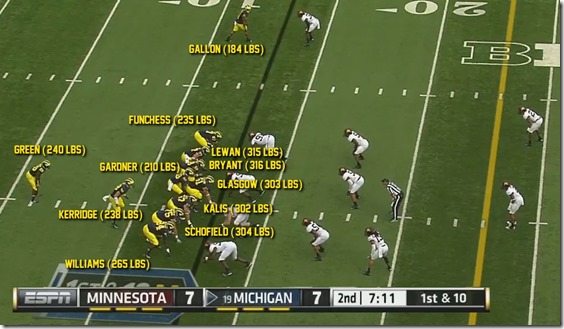
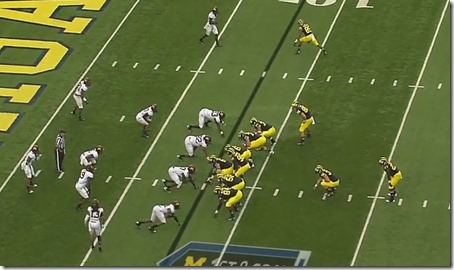
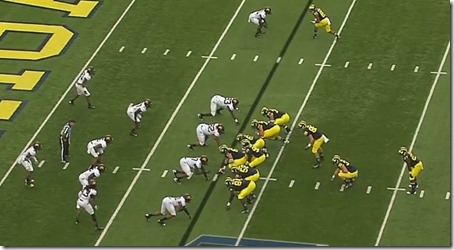
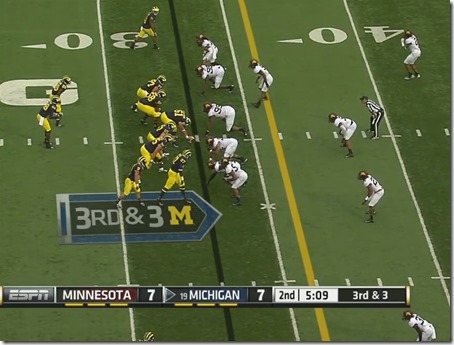

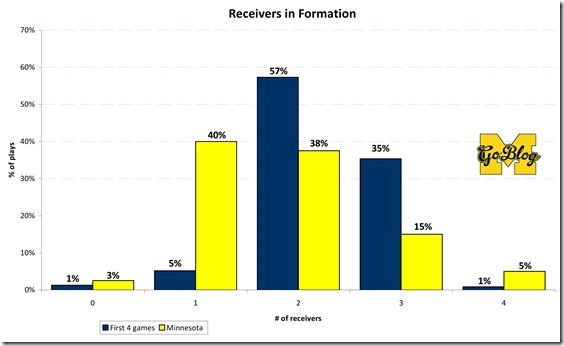
Comments